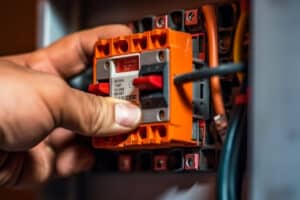What’s the Difference Between Manual and Automatic Transfer Switches?
Key Takeaways
- Manual transfer switches are more affordable and smaller in size compared to automatic transfer switches.
- Manual transfer switches require manual intervention to switch over from utility power to generator power, which can be inconvenient and time-consuming.
- Automatic transfer switches offer automatic detection and start-up of the generator, ensuring a quick and seamless transition from utility power to generator power.
When it comes to backup power systems, transfer switches play a crucial role in ensuring a seamless transition from utility power to generator power during outages. Manual and automatic transfer switches are two common types of switches used in these systems, each with their own advantages and disadvantages. In this article, we will explore the differences between manual and automatic transfer switches to help you understand which option may be best suited for your needs.
Manual Transfer Switches
Manual transfer switches are generally more affordable compared to automatic transfer switches. They have a simpler design with fewer components, making them easier and faster to fabricate and install. The lower cost and smaller size of manual transfer switches make them a popular choice for residential applications or businesses with infrequent power outages.
With a manual transfer switch, the user has full control over the switching process. During a power outage, the user needs to manually switch over from utility power to generator power. While this provides a level of control, it also requires manual intervention, which can be inconvenient and time-consuming.
Another drawback of manual transfer switches is the lack of automatic detection and start-up of the generator. This means that during a power outage, the user needs to be present and actively switch over to generator power. This can be a limitation for businesses that require uninterrupted power supply or areas prone to regular power outages.
Automatic Transfer Switches
Automatic transfer switches offer several advantages over manual transfer switches. One of the key benefits is the automatic detection and start-up of the generator during power outages. This means that when the power goes out, the automatic transfer switch senses the outage and automatically starts the generator, seamlessly transferring power without the need for manual intervention.
With an automatic transfer switch, the transition from utility power to generator power is quick and seamless, ensuring minimal downtime. This makes automatic transfer switches ideal for businesses where uninterrupted power is critical, or areas with regular power outages.
However, automatic transfer switches come with a higher cost compared to manual transfer switches. The additional technology and features make them more expensive to design, fabricate, install, and maintain. They are also larger in size and slower to fabricate, which can be a consideration for certain applications.
Another downside of automatic transfer switches is the complexity involved in their installation and maintenance. They have more components and technology, increasing the risk of potential issues or failures. Regular maintenance is required to ensure proper functioning and reliability.
Conclusion
In summary, manual transfer switches are a cost-effective option that provides full control over the switching process. They are suitable for areas with infrequent power outages or businesses where uninterrupted power is not critical. On the other hand, automatic transfer switches offer convenience, reliability, and a seamless transition to generator power. They are more suitable for areas prone to regular power outages or businesses where losing power could have serious consequences.
Whether you choose a manual or automatic transfer switch, professional installation is crucial to ensure safety and compliance with the National Electrical Code standards. Regular maintenance is also necessary to keep the transfer switch in optimal condition.
Related Websites:
FAQs:
Q: What is the purpose of a generator transfer switch?
A generator transfer switch serves the purpose of safely and efficiently transferring power from the utility grid to backup generators during power outages. It ensures a seamless transition and prevents backfeeding, protecting both the electrical system and the utility workers.
Q: What are the advantages of automatic transfer switches?
Automatic transfer switches offer convenience and reliability. They can detect power outages and initiate the switch to backup power without requiring any human intervention. Additionally, automatic transfer switches can perform regular self-tests and automatically start the generator if necessary, providing peace of mind.
Q: What are the limitations of manual transfer switches?
Manual transfer switches require human intervention to switch power sources and start the generator. This means physical presence is needed during power outages, which may not always be possible. It is important to consider this limitation and the inconvenience it may cause when choosing a transfer switch.
Q: What should I consider when choosing between manual and automatic transfer switches?
When choosing between manual and automatic transfer switches, it is important to consider factors such as cost, ease of use, and reliability. Manual switches are generally more affordable but require human interaction, while automatic switches operate autonomously but may come at a higher cost. It is crucial to evaluate individual needs and preferences to make the right choice.
Q: Why is a transfer switch important for backup power?
A transfer switch is important for backup power because it ensures a seamless transition from the utility grid to a backup generator during power outages. It prevents backfeeding, which can damage electrical systems and pose a safety risk to utility workers. Having a transfer switch in place guarantees a reliable and efficient source of backup power.






